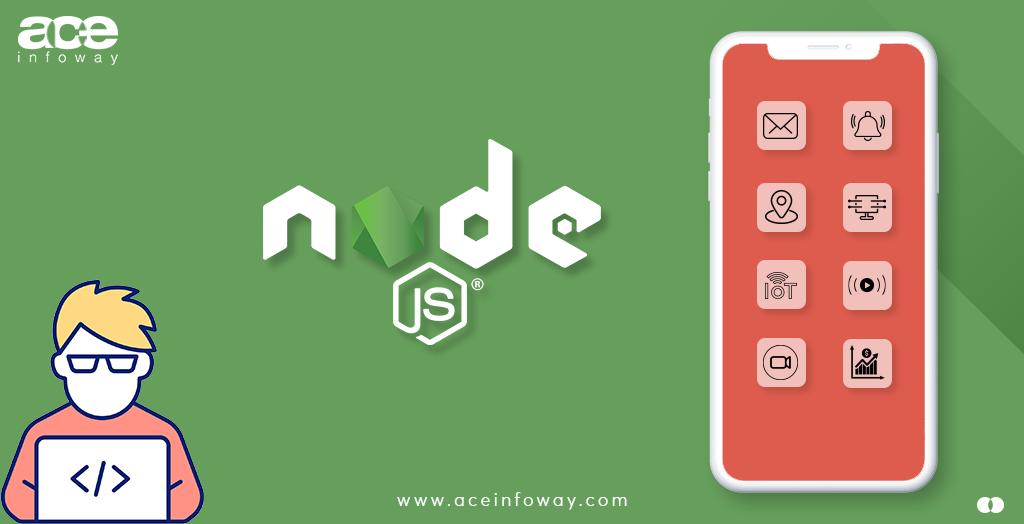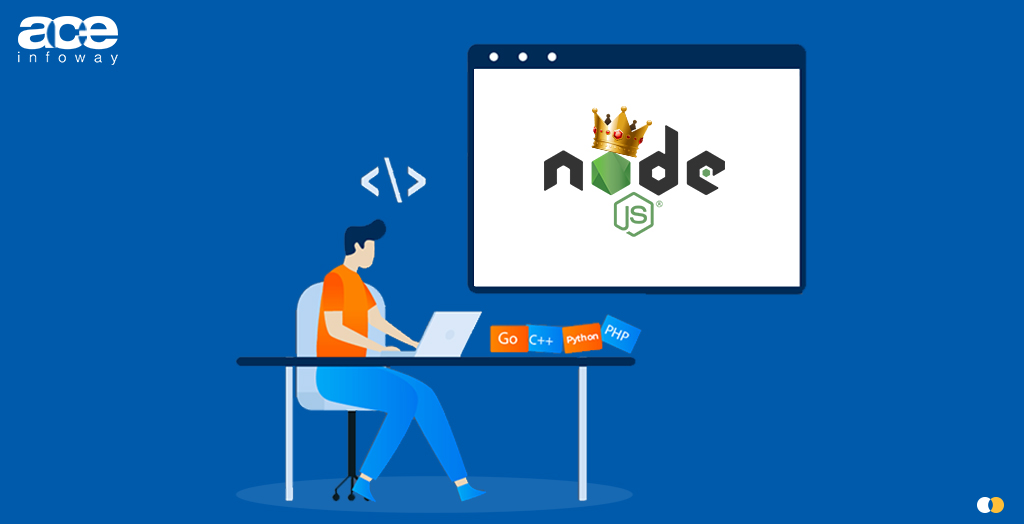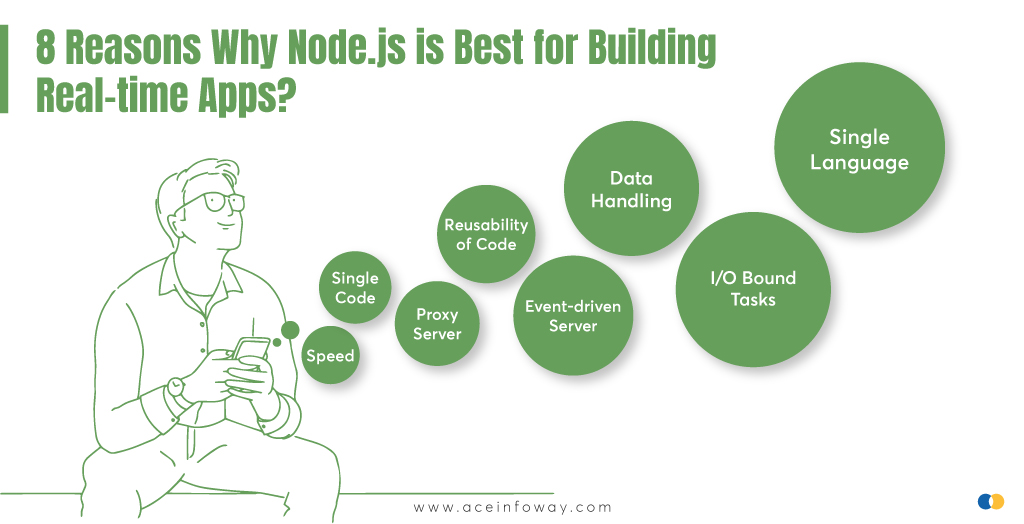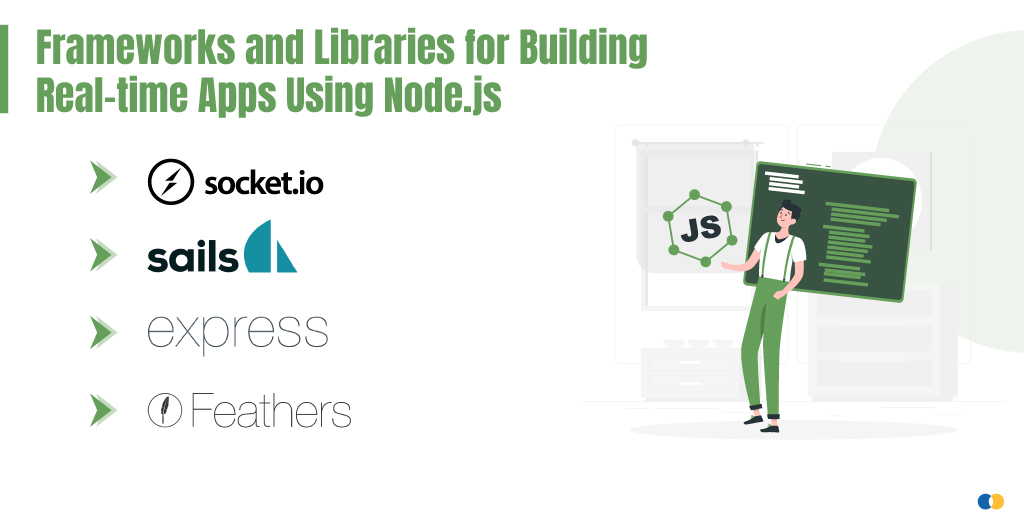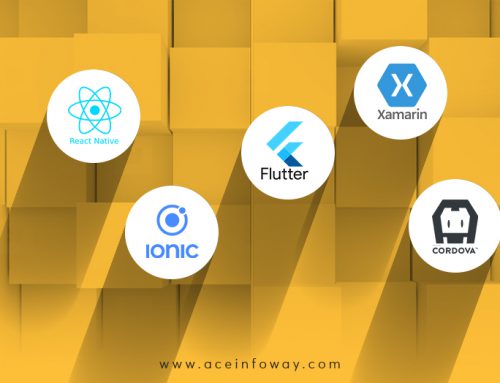Table of Contents
Today, everything is happening with a click of your fingertip at a lightning speed. So are the expectations of users have already exceeded with these technological advancements.
Today, Customers look for quick, convenient, and easy services. As a result, on-demand apps are surging all-time high.
Forbes reports that the on-demand economy attracts more than 22.4 million customers annually.

Node.js Performance Checklist
Get your free copy
This supports the assertion that the number of companies in the on-demand economy will increase in the future years, making the real-time functionality of an on-demand app increasingly crucial, and Node.JS will play a key part in achieving this goal.
Node.js has recently gained appeal as a platform for developing real-time applications. The primary advantage of Node.js is its asynchronous and event-driven approach, which makes it the best choice for real-time projects.
It’s ideal to create real-time web apps that respond nearly instantly to requests, even when large numbers of people are using them at the same time, due to technologies like Node.js, which can handle all of these demands easily.
Keep reading to find out why Node.js is such a popular technology for developing real-time apps:
What is Node.js?
Node.js is an open-source server-side JavaScript runtime environment that was launched in 2009 by Ryan Dahl and since then Node.js server-side JavaScript has become a solution to many problems.
Node.js operates the V8 JavaScript engine, the core of Google chrome, outside the browser. As a result, Node.js is extremely fast.
Node.js apps run in a single process, without creating a new thread for each request. Node.js standard library includes a set of asynchronous I/O primitives that prevent JavaScript code from blocking, and libraries in Node.js are often created following non-blocking paradigms, thus blocking activity is the exception rather than the norm.
Instead of blocking the thread and wasting CPU cycles waiting for a response, when Node.js conducts an I/O action, such as reading from the network, accessing a database, or accessing the filesystem, Node.js will resume the operations as the response comes back.
This allows Node.js to handle thousands of concurrent connections with a single server without adding the overhead of thread concurrency management.
Thus, Node.js is an excellent choice for developing real-time applications, and it will provide organizations with numerous benefits, including better productivity and usability.
What Makes Real-time App Development So Important?
Considering the momentum of digital advancements and a highly competitive market, building apps that users can use to interact in real-time has become a new standard norm for a majority of developers. Whether it is a web app, mobile app, or any other app it has now become vital to have at least one real-time feature. Real-time notifications and real-time messaging are the two most frequently utilized real-time features in applications.
Instant user interaction is becoming a popular UI feature for a growing number of apps. Real-time applications are a new classification that builds on the interactive feature and app concept.
The success of real-time apps is due to a variety of technological factors. The availability of data over a real-time network across devices has been a big contributing factor to the emergence of real-time apps. These new emerging trends in applications owe a lot to the cloud network and apps. Users nowadays expect their essential information to be shared over a live and real-time network. In most apps, the ability to share in real-time is a key feature.
Some of the best examples of real-time apps are:
- Online gaming
- Real-time operating system
- Instant messaging apps
- Video conference
- Voice over internet protocol
- A few eCommerce transactions
Reasons Why Node.js is Best for Building Real-time Apps
Real-time apps are expected to be extremely fast and scalable. As a result, only the greatest and most cutting-edge technology should be used. Compromise here implies disappointment for both you and your potential customers.
When it comes to non-blocking I/O operations, event-driven, single-threaded, asynchronous features, Node.js comes right on the top of the list.
Here are the reasons why Node.js is best and why use Node.js for building Real-time apps:
8 Reasons Why Node.js is Best for Building Real-time app
1) Speed:
The response time of a web application determines its quality. Users are tired of waiting for a web application to respond accurately in real-time, just as they are tired of waiting for your server to load.
Thankfully, Node.js allows you to handle large volumes of data in seconds and stream it back to your end-user without requiring an army of servers to keep up with all of the requests.
2) Single Code:
Node.js developers write the JavaScript for both the client and the server, making it easier to move data between the server and the client for optimal synchronization.
Because developers do not have to write code independently, single codebase techniques allow them to save time creating and executing code.
3) Proxy Server:
There are instances when you need to create a private space to store data and govern user behavior in application development.
However, keeping private information on your workstation can be challenging if you operate in a group. Using a proxy server that only stores HTTP headers, cookies, and other non-sensitive data is one way.
When your users hit an external domain name with something like node-HTTP-proxy, they won’t realize they’re working with an API server – it all appears to be seamless.
4) Reusability of Code:
Code reusability is one of the most important aspects of developing real-time web applications. When your skilled developers get stuck, they may rapidly seek advice from other team members or switch out various components to see whether it would help them proceed on the task at hand — without delaying anything else.
Node.js makes this considerably easier by giving you access to all accessible modules through communities like NPM (Node Package Manager).
5) Event-driven Server:
Real-time apps, as you know, deal with a large number of users at the same time. This is where the event-driven and asynchronous nature of Node.js comes into play. Due to its non-blocking functionality, Node.js allows developers to easily manage multiple requests with an event-driven server.
Furthermore, data transfer and synchronization are simple tasks for developers. Finally, data distribution to end-users will be faster and more seamless. That is why Node.js is so popular these days.
6) Data Handling:
Node.js is powerful when it comes to working with data. For example, when on the go, your users can provide real-time updates and even add new information to your database using their smartphones or tablets.
You can then execute some logic against that user’s data right away (as it comes in), or you can schedule it to be handled at regular intervals later on when you have time, whichever is ideal for your project.
All of this indicates that there will be less time between events and the actions made in response to them.
7) I/O Bound Tasks:
The majority of your time is spent waiting for the network, filesystem, and possibly database I/O to finish. The total performance can be improved by increasing the hard drive speed or the network connection speed.
Node.js is ideally suited for this type of computation in its most basic form. All I/O in Node.js is non-blocking, which means that other requests can be handled while you wait for a read or write to finish.
8) Single Language:
It’s no surprise that Node.js is rapidly gaining popularity as a platform for developing fast, scalable, and secure real-time applications. It only uses one programming language, JavaScript, making development easier than ever.
With this simplification of your project, you can maintain both backend systems because they are translated in just one file, making updates faster without having to rewrite anything or spend hours modifying code from different languages.
Frameworks and Libraries for Building Real-time Apps Using Node.js
1. Socket.IO:
Socket.io is a JavaScript library for developing real-time apps and creating bidirectional communication between web clients and servers. When a client has Socket.IO installed in their browser and a server has also installed the Socket.IO package, bi-directional communication is possible. While data can be delivered in a variety of formats, JSON is the simplest.
- Client-side: it is the library that runs within the browser
- Server-side: it is the library for Node.js
Socket.IO is used by many well-known companies, including Tech Stack, Alibaba Travels, Trello, and Bepro.
2. Sails.js:
Sails.js, sometimes known as Sails, is a real-time MVC framework for developing enterprise-ready Node.js applications.
The Sail was inspired by the Ruby on Rails MVC framework. Sails include WebSocket support out of the box, making it ideal for creating real-time chat apps, games, and more. Sails also include:
- Waterline is a Node.js adapter-based ORM that makes the data layer of your application a breeze.
- Saills is a command-line tool that helps you construct a new sails application, generate controller actions, start up the development server, do database migrations, and lots more.
Sails.js is used by many well-known companies, including POSTMAN, Microsoft, Amazon, and Philips.
3. Express.js:
Express.js is a Node.js web app framework to design and develop websites, web apps, and real-time APIs much easier.
Express.js is an excellent choice for agile development and rapid prototyping due to its flexibility, as well as its lightning-fast setup and Node’s pure JavaScript environment. Startups that want to build a product as quickly as possible and don’t have a lot of legacy code can use Express.js.
All of the major components of the framework are updated and reformatted regularly, which gives the framework a distinct advantage. It’s a lightweight framework for creating mobile apps and APIs.
Express.js is used by many well-known companies, including Netflix, IBM, eBay, and Uber.
4. Feather.js:
Feather.js is a lightweight web framework for Node.js that uses JavaScript or TypeScript to create real-time apps and REST APIs.
It’s packed with features that make developing modern web and mobile apps. Developers can use FeathersJS to control data using RESTful resources and connections. Simultaneously, the JavaScript framework’s REST APIs make it easy for developers to link and communicate their web apps with numerous third-party applications and services. FeathersJS can also be integrated with several popular JavaScript frameworks and development tools.
Famous Real-time Apps Built Using Node.js (Use Cases)
We’ve compiled a list of companies that have implemented Node.js and seen measurable and positive results, come let’s check out which are they:
1) Uber
It was among the first 3 companies to implement Node.js. Uber is a well-known company that provides taxi services and uses Node.js in production. Uber cited its asynchrony feature, capacity to process enormous volumes of data almost instantly, concise code, and minimal implementation costs as important reasons for deploying Node.js.
Furthermore, the driver-passenger matching algorithm is the core of this app. For this, Uber required an event-driven feature, short but powerful code, and the ability to handle massive loads. These all features can be implemented with the help of Node.js.
Why Did Uber Implement Node.js?
This technology, according to Uber, has three main advantages:
- Processes large amounts of data quickly.
- Developers can inspect errors without requiring a restart, allowing developers to constantly publish and deploy new code.
- An active open source community continuously optimizes the technology, ensuring that it improves on its own.
2) Netflix:
You likely think of Netflix when you hear the phrase “streaming.” From a DVD store to the world’s largest streaming service and its production, this company has come a long way. How do they manage to serve millions of users at the same time?
All this is possible with the sleek combination of Java and Node.js on the backend. Previously, a single monolith groovy app maintained all APIs for a variety of platforms (including iOS and Android, desktop operating systems, and multiple TV devices).
However, Node.js now allows Netflix to create rectify instances and execute them in various Docker containers. The app became more scalable, faster, and had better versioning as a result. The time it took to develop the product was also drastically reduced.
Why Did Netflix Implement Node.js?
“The team has decided to implement Node.js to develop a lightweight, modular, and fast application. As a result, their new app’s start time has been reduced by 70%”
3) Groupon:
Groupon is an eCommerce platform offering discounts to customers for travel, goods, salon, restaurant, and other services. It collaborates with third-party firms to offer unique discounts and deals. In 2015, Groupon, like Linkedin, migrated from Ruby on Rails to Node.js.
Node.js was used by Groupon software developers to migrate both their mobile and web traffic. Their main reason for Groupon to adopt Node.js was to increase scalability, yet the switch from Ruby on rails to Node.js resulted in resource reduction for high traffic and speedier web pages.
Why Did Groupon Implement Node.js?
“Sean McCullough, a former software engineer at Groupon mentioned that they choose Node.js because of the growing community, NPM, performance, and scalability as factors.”
Groupon States:
“In comparison to the old stack, we’re serving the same amount of traffic with less hardware. Teams can individually deploy modifications to their applications. With our new architecture, we’ve been able to make a site-wide feature and design changes far more quickly than we could with our old architecture.”
4) PayPal:
PayPal is one of the most popular online payment systems, serving millions of users across many countries. The user-facing content element of PayPal’s application is built with Node.js.
Node.js integrates JavaScript on the frontend and backend of every app. PayPal, for example, likes Node.js because it speeds up its development process.
Node.js has given PayPal a faster web application loading time, which is nearly twice as fast as their previous Java-based application.
Why Did PayPal Implement Node.js?
PayPal’s Senior Director of Payments Products and Engineering, Jeff Harrel, states:
“By allowing both browser and server apps to be built in JavaScript, Node.js helps us tackle this border between the browser and the server. It brings together all of our engineering expertise into a single team, allowing us to understand and respond to our users’ needs at any point in the technology stack.”
5) LinkedIn:
LinkedIn is the most popular business-oriented social networking site and a useful tool for successful employment.
LinkedIn chose an asynchronous event system to replace their synchronous Ruby on Rails mobile app, which required clients to make many calls for a single page. As a result, they chose Node.js because of its scalability and performance efficiency. And Node.js met their requirements.
Why Did LinkedIn Implement Node.js?
According to Deepak Gupta, LinkedIn’s Senior Software Engineer:
“The development of Node.js also encourages you to think in specific ways. Node is a vented system that uses a single process to handle numerous requests. It has no understanding of thread-locals, which forces you to write stateless and modular programs.”
Types of Real-time Web Apps you can Build with Node.js
-
Real-time Chat Apps:
One of the best aspects of Node.js is the ability to create real-time network applications. From simple real-time chat applications like instant messaging (IM) and internet relay chat (IRC) to more complex real-time applications, you can do it all.
Using the Event API, Node.js provides basic tools for developing and delivering real-time and network applications. It can generate emitters, which are objects that emit named events regularly and can be listened to by event handlers.
Node.js works well with the WebSockets protocol because of its event-based architecture, allowing for real-time two-way communication between the server and the client.
WebSockets are well-supported in Node.js, thanks to packages like Socket.io and WebSocket-node, which you can use to quickly and easily build & deploy real-time chats.
-
Internet of Things (IoT):
Node.js has been the chosen engine for building enterprise and organization-level solutions for private and public IoT systems since the introduction of the IoT in 2012.
Node.js can handle many concurrent requests and events from millions of IoT devices across the internet, which is a requirement for any IoT device.
For example, Skycatch utilizes Node.js to power its specialized drones that take building site images and turn them into 3D models — a task that would be considerably more difficult without Node.js.
-
Single Page Apps:
Single-page applications (SPAs) aren’t quite new in the world of web development. It’s a common buzzword that refers to a design strategy in which the entire application is integrated on a single page with a better developer experience.
Node.js is best for SPAs because it performs asynchronous calls and large input/output (I/O) workloads faster and more quickly. The Node.js event loop is permitted to “delay” numerous concurrent requests from clients, allowing for smooth processing. This allows for a seamless movement of data between Views and the server.
With its data-driven approach, Node.js is also a good choice for building out the backend of a SPA. To create a complicated and data-intensive SPA backend, JavaScript frameworks such as Express.js, Adonis.js, or Koa can be used.
-
Microservices Architecture:
Microservices are the division of an application into groups of independent and modular services, each running as a separate single process.
Microservice architecture is well supported by Node.js, which supports the division of big and complicated applications into smaller, independent functional units.
The microservice architecture of Node.js decreases development time while also improving maintainability, scalability, and efficiency. PayPal has proven this by using Node.js to develop the world’s most popular online payment service.
-
Real-time Collaboration Tools:
Node.js is a powerful technology that can be used to create real-time collaborative tools such as coworking apps, project management, video and audio conferencing, and collaborative document editing.
That’s why Node.js is the foundation for many popular collaboration applications owned by huge tech businesses, such as Trello for project management and Slack for group chats and remote team interactions.
The asynchronous and event-based architecture of Node.js offers the base for developing and scaling collaborative applications.
-
Streaming Apps:
The process of downloading parts of an application on-demand without overloading the server or the user’s local system is known as application streaming.
Node.js can easily manage real-time data streams, which are the fundamental characteristic of a streaming application, thanks to the stream API. The Node.js event loop can also provide speedy data synchronization between the server and the client, which improves the user experience by reducing the wait time.
Node.js has a read and writable stream interface that can be used to efficiently process data streams.
Conclusion
We have covered detailed information about Node.js for real-time app development and it can be concluded that Node.js is a perfect option for businesses looking to build real-time apps due to its scalability, powerful data handling, single code, and so forth.
If you are looking to develop a real-time app then you must give Node.js a try. At Ace Infoway, you can hire professional and skilled Node.js developers to develop your visionary app and increase your customer base.

Node.js Performance Checklist
Get your free copy
Why Ace Infoway for Developing Real-time Apps using Node.js?
With a skilled and experienced Node.js team, we assist clients globally in developing feature-rich, high-end, and scalable products.
We have Expertise in building real-time chat apps, IoT, single-page apps, streaming apps, and many more.
Our Node.js developers can help you with your specific project needs. Customers who require technical competence and knowledge for their projects can hire one of our specialist Node.js developers to get best Node.js Development Services. Our professional Node.js developers are not just coding experts, but they also understand what our customers demand and are dedicated to delivering a high-quality product that meets their needs.
Team up to hire expert Node.js developers to build real-time apps.









